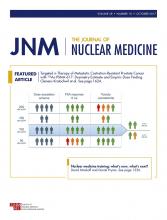Article Figures & Data
Tables
Study Design Patient population n PET after “Positive” equivalent to PET-negative therapy PET-positive therapy Median follow-up Outcome Radford RAPID 2015 (5) RCT Stage IA–IIA nonbulky 571 3×ABVD DS 3–5 IFRT or NFT 1×ABVD+IFRT 60 mo 3-y PFS PET-neg: IFRT 94.6% vs. NFT 90.8% (intention-to-treat analysis); IFRT 97.1% vs. NFT 90.8% (per-protocol analysis) 3-y OS PET-neg: IFRT 97.1% vs. NFT 99.0% 3-y PFS PET-pos: 87.6% André H10 2017 (6) RCT Stage I–II supradiaphragmatic 1,925 2×ABVD DS 3–5 1×ABVD+INRT or 2×ABVD (favorable); 2×ABVD+INRT or 4×ABVD (unfavorable) 1×ABVD+INRT or 2×BEACOPPesc+INRT (favorable); 2×ABVD+INRT or 2×BEACOPPesc+INRT (unfavorable) 4.5 y 5-y PFS PET-neg: INRT 99% vs. NFT 87.1% (favorable); INRT 92.1% vs. NFT 89.6% (unfavorable) 5-y OS PET-neg: INRT 96.7% vs. NFT 98.3% (favorable); INRT: 92.1% vs. NFT 89.6% (unfavorable) 5-y PFS PET-pos: ABVD+INRT 77.4% vs. BEACOPPesc+INRT 90.6% 5-y OS PET-pos: ABVD+INRT 89.3% vs. BEACOPPesc+INRT 96.0% Johnson RATHL 2016 (7) RCT Stage IIB adverse features, III–IV 1,119 2×ABVD DS 4,5 4×ABVD or 4×AVD BEACOPP-14 or BEACOPPesc 41 mo 3-y PFS PET-neg: ABVD 85.7% vs. AVD 84.4% 3-y OS PET-neg: ABVD 97.2%; AVD: 97.6% 3-y PFS PET-pos: BEACOPP 67.5% 3-y OS PET-pos: 87.8% PET-pos Engert HD15 PET substudy 2012 (10) RCT Stage IIB+adverse features, III–IV with PR&>2.5 cm residual mass 1,578 6× or 8×BEACOPPesc or 8×BEACOPP14 DS 3–5 NFT RT 4-y PFS: 92.6% PET-neg; 86.2% PET-pos Press S0816 2016 (13) Ph II Stage III–IV 336 2×ABVD DS 4,5 4×ABVD 6xBEACOPPesc 39.7 mo 2-y PFS: 81% PET-neg; 64% PET-pos; 98% 2-y OS Zinzani HD0801 PET2-pos 2016 (12) Ph II Stage IIB–IV 103 2×ABVD DS 3–5 Not applicable 4×IGEV+BEAM ASCT or melphalan allograft 27 mo 2-y PFS PET2-pos: 81% PET4-neg; 76% PET4-pos; 97% 2-y OS Borchmann HD18 PET2-pos 2017 (16) RCT Age 18–60 y; stage IIB+adverse features, III–IV 440 2×BEACOPPesc DS 3–5 Not applicable 6×BEACOPPesc or R-6BEACOPPesc 33 mo 3-y PFS PET2-pos: BEACOPPesc 91.4% vs. R-BEACOPPesc 93.0% 3-y OS PET2-pos: BEACOPPesc 96.5% vs. R-BEACOPPesc 94.4% RCT = randomized clinical trial; ph II = prospective phase II study; IFRT = involved-field radiotherapy; NFT = no further treatment; neg = negative; pos = positive; INRT = involved-node radiotherapy; RT = radiotherapy; IGEV = ifosfamide, gemcitabine, and vinorelbine; BEAM = carmustine, etoposide, cytarabine, and melphalan; ASCT = autologous stem cell transplantation; R-CHOP = rituximab, cyclophosphamide, doxorubicin, vincristine, and prednisone; PR = partial response.
Study Design Patient population n PET after “Positive” equivalent to PET-negative therapy PET-positive therapy Median follow-up Outcome Duehrsen PETAL 2014 (17) RCT Aggressive NHL (80% DLBCL) 853 2×R-CHOP <66% ∆SUV reduction 4×R-CHOP or 4×R-CHOP+2R 6×R-CHOP or 6×Burkitt protocol 33 mo 2-y TTF: PET-neg 79%; PET-pos 47%; 2R, no difference (HR 1.2, 95% CI 0.8–2.1) Intensification: no difference (HR 1.6, 95% CI 0.9–2.7) Sehn BCCA 2014 (18) Ph II Advanced-stage DLBCL/PMBCL 155 4×R-CHOP DS 3–5 2×R-CHOP 4×R-ICE+RT if EOT PET-pos 45 mo 4-y PFS: PET-neg 91%; PET-pos 59% 4-y OS: PET-neg 96%; PET-pos 73% Hertzberg ALLG 2017 (19) Ph II Poor-risk DLBCL 151 4×R-CHOP DS 3–5 2×R-CHOP+2R 3×R-ICE+Z-BEAM ASCT 35 mo 2-y PFS: PET-neg 74%; PET-pos 67% 2-y OS: PET-neg 78%; PET-pos 88% (P = 0.11) PETAL = PET-guided therapy of aggressive lymphomas; DLBCL = diffuse large B-cell lymphoma; (R-)CHOP = (rituximab) cyclophosphamide, doxorubicin, vincristine, and prednisone; 2R = 2 cycles rituximab; TTF = time to treatment failure; BCCA = British Columbia Cancer Agency; (R-)ICE = (rituximab) ifosfamide, carboplatin, etoposide; EOT = end of treatment; ALLG = Australasian Leukaemia Lymphoma Study Group; Z-BEAM = ibritumomab tiuxetan, carmustine, etoposide, cytarabine, and melphalan; ASCT = autologous stem cell transplantation; R-CHOP = rituximab, cyclophosphamide, doxorubicin, vincristine, and prednisone.







